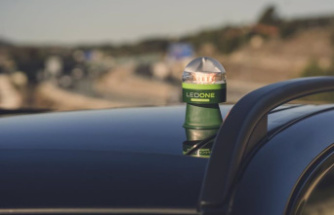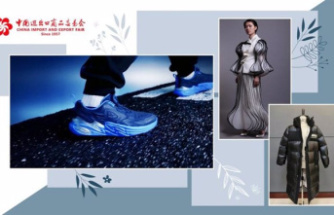When you enter Pavilions on Antonio Parkway in Rancho Santa Margarita, you might stop and wonder if your eyes are deceiving you. Close to the front door of the supermarket stands a huge refrigerated display case filled with champagne and sparkling wine.
Behind it is a 500-bottle walk-in cooler stocked with some of California’s most prestigious wine labels: Pahlmeyer, Daou, Paul Hobbs, Grgich. They’re surrounded by row after row of wine, beer and spirits — more than 4,000 items in all, making this Pavilions’ inventory roughly the size of a mid-size standalone liquor retailer.
Bringing an expanded selection of alcoholic beverages to the front of the store is a concept that’s going big soon. Orange County is home to the first two: the Antonio Parkway location, which officially opened on Wednesday, and Pavilions store No. 1911 on Newport Coast Drive in Newport Beach, which will bow on Wednesday.
Then the plan is to take it to more than 50 of the 354 Albertsons, Vons and Pavilions stores in Southern California.
“The bubbly display was put there to make a statement that we’re serious about this,” said Phil Markert, sales manager for liquor at Albertsons, Vons and Pavilions’ Southern California division. He added that the company plans to match the impressive selection with expertise.
“We have 100 wine stewards on staff throughout the division. We do training every eight weeks with wine sommeliers and whiskey ambassadors. We have a vibrant training program.”
His company aims to train and inform its customers too, Markert said. “We do winemaker dinners throughout Southern California to educate our consumers on wine. They’re very popular.”
Jenna Watkinson, the company’s director of public affairs for Southern California, said her company has done its homework, working carefully to match inventory in each store with the preferences of its community. Markert showed what that means for the Rancho Santa Margarita Pavilions.
“Picnics are popular around here,” he said. (O’Neill Regional Park is close by.)
“So we cater to the picnic set with a large selection of half bottles and wine in a can. On the opposite end, we know that entertaining at home is important to our customers, so we’re offering a nice selection of premium wines in magnums.”
Like many supermarkets, Pavilions’ expanded wine inventory includes many familiar labels offered through large conglomerates such as Gallo, Constellation and Diageo. But surprisingly, independent winemakers are well-represented on the shelves, too.
“We have great relationships with small, family-owned wineries,” Markert said. “Personally, I'm more into finding those highly allocated niche wines from small producers. We have a wine shop mentality. This place will rival anything you see in a fine wine store.”
Markert had just returned from a trip to Napa, where he talked business with several small-output wineries.
Imported wines are well represented here as well – more than 800 labels from South Africa, Argentina, Chile, Spain, Germany, France, Italy, New Zealand and Australia. Markert is fond of Provencal roses, and he stocks more of them than many wine stores.
On a different row you’ll find high-end liquor such as Bruichladdich’s legendary interpretation of scotch. Close by is a brew section that includes some of Southern California’s most popular craft beermakers, including a healthy contingent from San Diego, one of the nation’s beer capitals.
Markert’s enthusiasm is palpable, but if you’re an O.C. resident, you could be forgiven for harboring a sliver of doubt about Pavilions’ gambit. Beverages & More, Total Wine & More, Hi Time, Costco, Trader Joe’s – isn’t Southern California already awash in a plethora of wine, beer and spirits choices, much of it at affordable prices?
“We’re confident in our research,” Watkinson said. “We think people will like the idea of buying quality wine at the place where they do their other shopping rather than making a separate trip for that.”
Industry experts confirm the validity of Pavilions’ marketing strategy. “It has been tried in similar situations in other parts of the country — very successfully in the East,” said Burt P. Flickinger III, managing director of Strategic Resource Group, a New York-based consumer industry consulting firm.
“It’s a very savvy strategic initiative on the part of Vons, which tends to attract more of an upper-middle income shopper who is buying wine both for everyday (consumption) and special occasions. In terms of both buying and merchandising,
Vons has a tremendous amount of skill and expertise in fine wine. This (concept) is analogous to what (the late Trader Joe’s executive) John Shields did when he expanded to a finer palate of wines for Trader Joe’s at very good values.”
Vons, like all retailers, undoubtedly keeps a close eye on larger retail and consumption trends, and for wine the numbers look very positive. Total U.S. wine consumption continues to rise — Americans now drink an average of 2.83 gallons of wine per year, 15 percent more than 2008.
From 2010 to 2016, the U.S. wine industry’s sales growth averaged 9.7 percent per year. Compare those two numbers and it’s obvious that we’re not only drinking more wine, but we’re also willing to pay more for each bottle.
Others are taking advantage of the trend, too.
“Both Total Wine and BevMo are moving to expand their product portfolio in California,” Flickinger said. Consumers’ increasing interest in high-end and small-production wine is good news for that part of the industry, he added. When powerful buyers such as Vons and Trader Joe’s start buying and marketing them, “oftentimes they contract for (those wines) on a long-term basis.
They commit to a big percentage of their product, which gives (the winery) the cash flow to expand and prosper much more quickly.” Vons is also capitalizing on Southern California’s higher-than-normal level of wine knowledge and appreciation as well as the area’s many neighborhoods with high disposable income, Flickinger said.
The final factor motivating Vons’ new initiative could be consumers’ increasing knowledge of restaurant wine pricing. “Twenty years ago, white-tablecloth restaurants would mark up their wine 200 or 300 percent,” Flickinger said. “Now it’s a lot more — in many cases 500 percent and even more.” Even with restaurant corkage charges of $20 or $25 per bottle, bringing in your own wine makes sense, especially for fine wine.
Wine, beer and spirits are an increasingly important portion of a grocery store’s revenue, so displaying them more prominently makes sense, Flickinger said. He predicted that large front-of-store displays will become the new normal.
“It’s the most productive real estate within (a supermarket’s) four walls. Putting it out front tells shoppers, ‘We care. This is important. You don’t have to walk to the back corner like your mom and dad did.’ ”
Our editors found this article on this site using Google and regenerated it for our readers.













